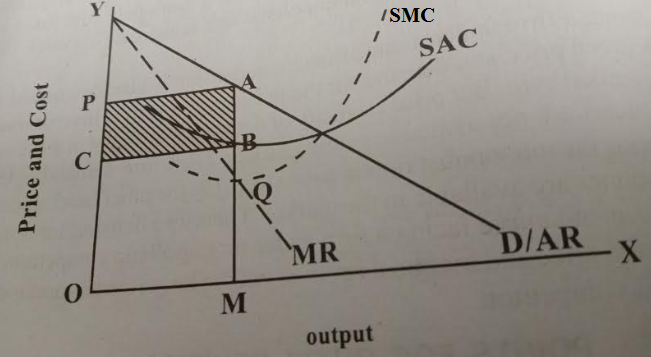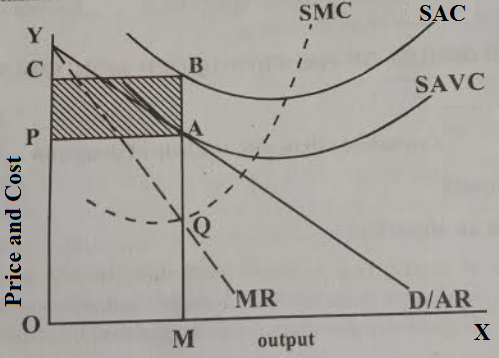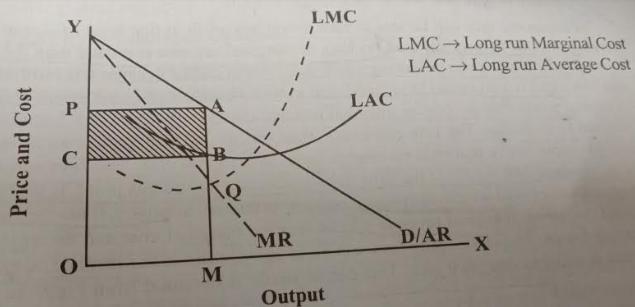Equilibrium of the firm under Monopoly
Here, we understand about equilibrium of a monopoly firm with the help of diagram in detail.

Do you have similar website/ Product?
Show in this page just for only
$2 (for a month)

0/60
0/180
EQUILIBRIUM OF THE FIRM UNDER MONOPOLY
we will discuss the equilibrium of a monopoly firm in detail explanation with diagram. To understand better, we discuss firstly Profit maximisation and Secondly, Short term equilibrium of the monopolist.
- Profit maximisation as an objective: A firm under any type of market that perfect competition, monopoly etc. aims at profit maximisation. we analysed the behaviour of firms under different market conditions. Monopoly associated with large abnormal profits, known as profiteering.
- Short term equilibrium of the monopolist: To attain equilibrium position the monopolist fixes his output and price at the price where MC = MR. Its the rule for equilibrium condition. This equilibrium consistent with either abnormal profit or minimum losses. We will graphically explain both the possibilities as follows:
We noted that the monopolist determines his output at the point where MC becomes equal to MR. If the price or AR set at this point is greater than his average cost (AC), the profit of the monopolist will be abnormal in nature as shown in below mentioned figure-
Figure- 
As shown in figure, here output is measured on X-axis and price and cost on Y-axis. MC curve cuts MR curve at point Q. It indicates the output is equal to OM and price is OP or MA. Thus total revenue = OMAP, OC or MB is the average cost. The profit per unit is equal to BA and total profit is equal to ABCP that shown in shaded area. This profit is considered as abnormal because price i.e. AR > AC.
[II] Equilibrium with minimum losses (P < AC)
It is noted that the monopolist is in equilibrium in the short run with minimum loses.
Figure- 
As shown in above figure, above the MC = MR at point Q. The output = OM and the price AM = PO which is less than short run average cost BM. The per unit loss = AB and the total loss = ABCP. The price PO = average variable cost (AVC). The loss = fixed cost which not covered by the price. Here, the monopolist continues production with losses in the short run because even if he suspends production, he will bear losses on account of fixed costs which are already incurred by him. In short run the minimum price to continue production is equal to AVC. If the price is less than AVC he will close down as even the running expenses not recovered. Besides if such losses continue in the long run he will think of closing down.
[III] Equilibrium in long run (abnormal profit: Price > AC)
In the long run under monopoly price always exceeds average cost (AC). The reason behind that monopolist being the only seller/producer enjoys the power to manipulate price and to make maximum possible profit.
Figure- 
As shown in above figure, Output on X-axis and Price and Cost on Y-axis. The output OM as decided by point Q where MC curve cuts MR curve. Indicates the price as decided by the demand or AR curve is equal to = OP or MA. The average cost is equal to MB or OC. It is less than the price OP or MA. Here, the per unit of profit is BA and the total profit - PABC shaded area as shown in figure. Price greater than average cost the profit is always abnormal.
Short form used-
SMC = Short run marginal cost.
SAC = Short run average cost.
SAVC = Short run Average Variable Cost.
LMC = Long run Marginal Cost.
LAC = Long run Average Cost.
CONTINUE READING
Equilibrium of the firm under Monopoly
Profit Maximisation as an Objective
Short term equilibrium of the monopolist
Abnormal Profit
Average Cost
Marginal Revenue
Normal Profit
Minimum Losses
Long run Marginal Cost
Long run Average Cost
Short run Average Variable Cost
Short run marginal Cost
Short run Average Cost.
Monopoly - Equilibrium of the firm under Monopoly.
Kinnari
Tech writer at NewsandStory
